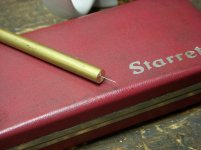Mike1974
Diamond
- Joined
- Nov 5, 2014
- Location
- Tampa area
I just asked our manual lathe guy if he could turn a piece of 1/2 hard brass .012" dia x .13 long. He said "yep, no problem, done them before" !! 

Anyone else doing turning that small?


Anyone else doing turning that small?







